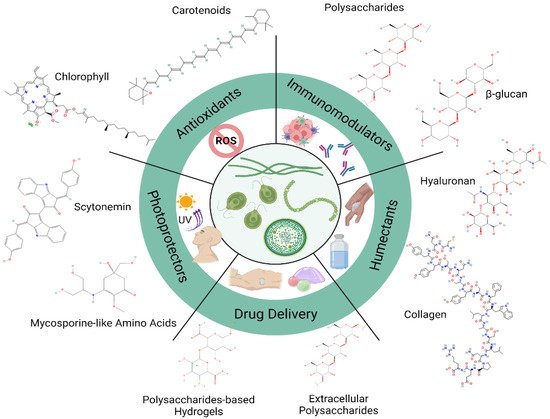You're using an outdated browser. Please upgrade to a modern browser for the best experience.
Please note this is a comparison between Version 1 by MANUEL MARTINEZ RUIZ and Version 2 by Lindsay Dong.
Microalgae are complex photosynthetic organisms found in marine and freshwater environments that produce valuable metabolites. Microalgae-derived metabolites have gained remarkable attention in different industrial biotechnological processes and pharmaceutical and cosmetic industries due to their multiple properties, including antioxidant, anti-aging, anti-cancer, phycoimmunomodulatory, anti-inflammatory, and antimicrobial activities. These properties are recognized as promising components for state-of-the-art cosmetics and cosmeceutical formulations.
- microalgae
- bioactive compounds
- photoprotectants
- immunomodulator
- antioxidants
1. Introduction
Algae are a diverse group of photosynthetic eukaryotic microorganisms that possess different structures and forms and can be divided into either macro or microalgae based on their size. Many microalgae species have been identified as having various biochemical characteristics associated with nutritional benefits and human health.
Microalgae synthesize an extensive diversity of compounds from different metabolic pathways such as amino acids, fatty acids, lycopene, polysaccharides, steroids, carotenoids, lectins, polyketides, toxins, etc. Some of these are shown in Figure 1.

Figure 1.
Molecular structure from microalgae-derived compounds used for multiple biotechnological applications.
Microalgae produce and secrete valuable metabolites as a result of being constantly exposed to several stress conditions, such as high or low temperature, high salinity, osmotic pressure, photo-oxidation, and ultraviolet radiation [1][9]. Furthermore, it is widely recognized that microalgae metabolites exhibit a wide range of biological activities such as ultraviolet (UV) absorbing, antioxidant, anti-aging, anti-blemish, anti-inflammatory, and antimicrobial properties [2][3][1,14]. Additionally, microalgae capture CO2 more efficiently than trees, reducing the greenhouse effect [4][15].
2. Immunomodulatory Activity of Compounds from Microalgae
Microalgae and cyanobacteria serve as a source of bioactive compounds that present immunomodulatory activity, such as amino acids [5][6][7][28,29,30], peptides, pigment-protein complex, and exopolysaccharides, the latter known to possess anti-inflammatory, antimicrobial, and antiviral properties [2][8][9][10][11][1,31,32,33,34]. The major sugars involved in the composition of polysaccharides are xylose, glucose, mannose, and galactose [12][35]. Specifically, sulfated polysaccharides have been associated with blood coagulation, antilipidemic activity, and mainly immunomodulatory activity [8][31]. Multiple studies have reported anti-inflammatory properties from Arthrospira/Spirulina, Chlorella vulgaris, Chlorella pyrenoidosa, Isochrysis, Pleurochrysis carterae, Dunaliella, Porphyridium purpureum, and Rhodosorus marinus [6][12][13][14][15][16][29,35,36,37,38,39].
Immunomodulatory agents refer to compounds that increase (immunostimulators) or decrease (immunosuppressants) the response of the immune system. In cosmetology, topical immunomodulators are used to regulate the local immune response of the skin to treat a wide range of skin diseases [17][18][40,41]. Moreover, topical immunomodulators are easier to apply and safer for longer periods in comparison with systemic immunomodulators [17][18][19][40,41,42].
Anti-inflammatory, antitumoral, antimicrobial, and antiviral properties from a wide variety of compounds are directly linked to immunomodulator activities as they work synergistically with the immune system to elicit an anti-inflammatory response against damaged tissue or act against external microorganisms, interfering with their growth and activating apoptotic cell death. All of these properties have made microalgae metabolites feasible for use as immunotherapy to treat some of these disorders, as mentioned before [5][6][7][28,29,30].
The immune system coordinates its response via multiple signaling pathways, and these responses when unregulated contribute to the pathogenesis of chronic inflammatory skin diseases [20][43]. The immunomodulator mechanisms include cytokines, interferons, interleukins, and tumor necrosis factors, secreted primarily by macrophages, lymphocytes, and keratinocytes in the epidermis [5][21][28,44]. Additionally, various factors such as uncontrolled responses to pathogens, toxic substances and reactive oxygen species (ROS)-mediated oxidative stress promote the release of pro-inflammatory mediators [5][22][28,45]. Accordingly, immunomodulatory agents are used to inhibit inflammatory responses and fight diseases.
In vitro and in vivo studies have shown the immunomodulatory and anti-inflammatory potential of microalgae-derived bioactive compounds and extracts [23][24][25][50,51,52]. In vitro studies of sulfated polysaccharides from red microalgae Porphyridium showed that the polysaccharide inhibited the movement of polymorphonuclear leukocytes, producing an anti-inflammatory effect, while in vivo studies showed that the topical application of the polysaccharides in humans inhibited the development of erythema [24][51]. Furthermore, immunostimulatory activity has been observed from in vitro assays involving microalgal material such as Spirulina platensis extracts, revealing an increase in human dermal fibroblast cell proliferation and enhanced wound area closure rates [25][52].
